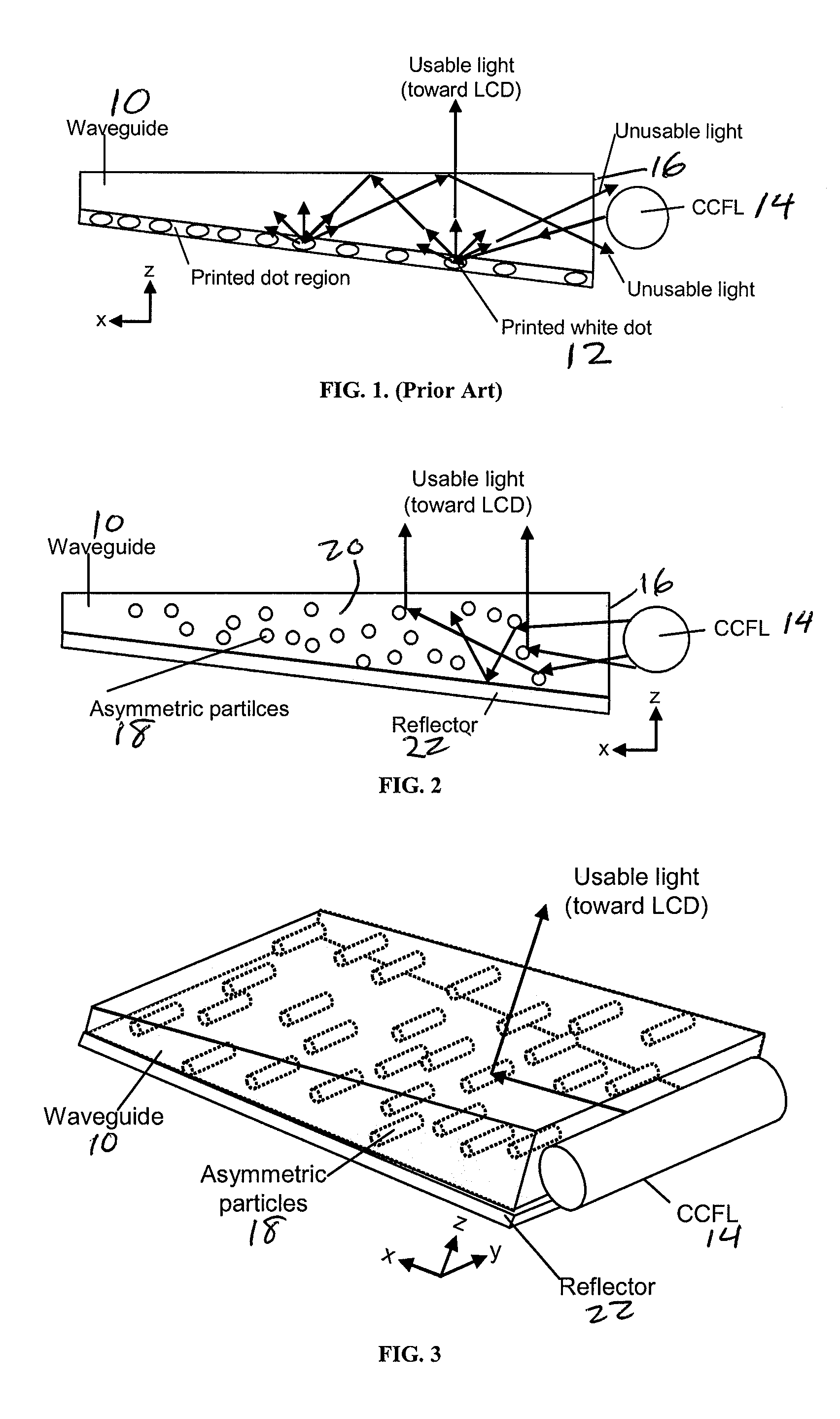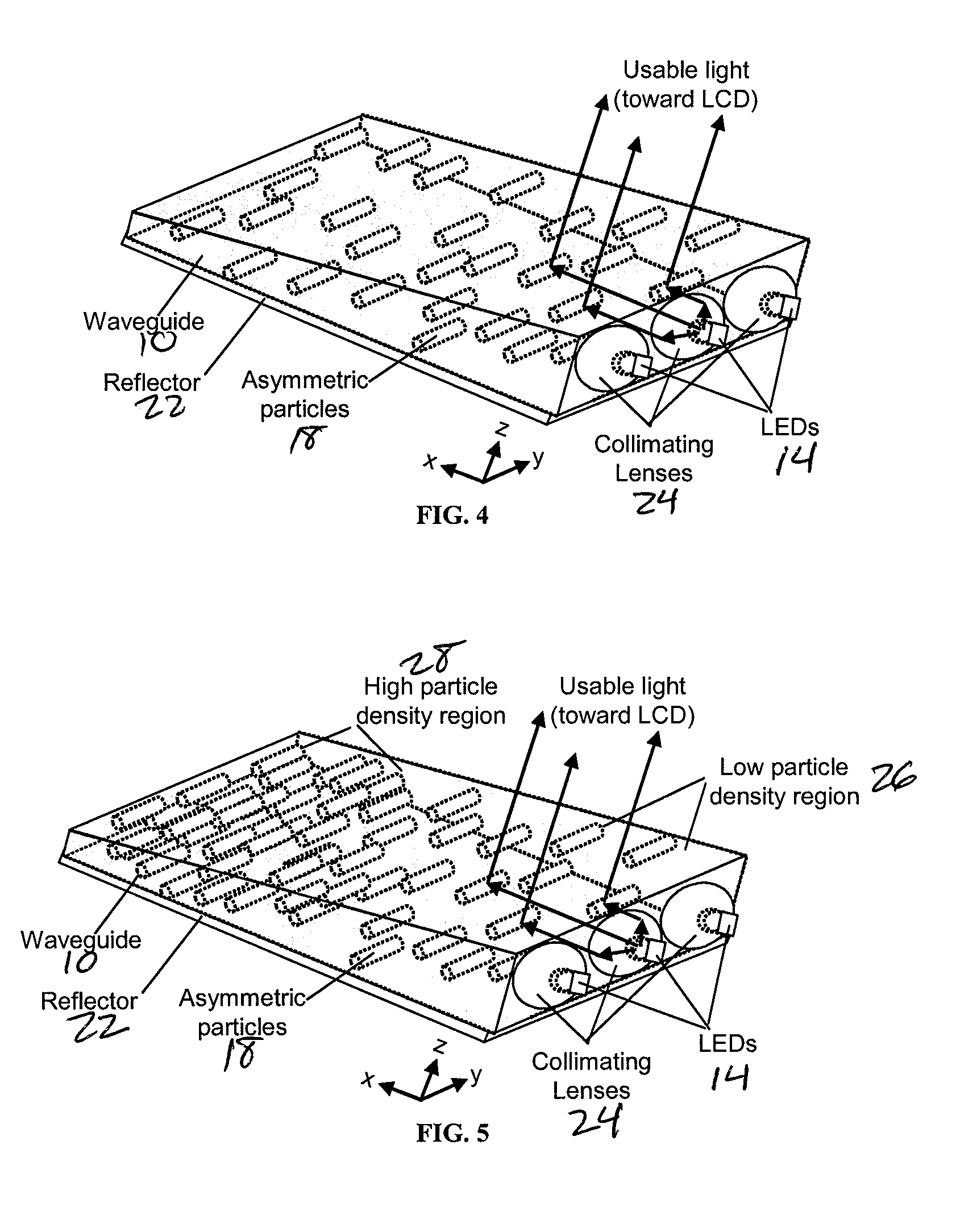Enhanced LCD backlight
a backlight and lcd technology, applied in the field of enhanced backlights, can solve the problems of poor control over the angular spread of the reflected light from the dots, poor control over the light, directing light into wide angles and viewing zones, dimmer displays or lost electrical power, etc., to achieve the effect of improving the backlight assembly, improving the optical efficiency, and increasing the flexibility of display system designers
- Summary
- Abstract
- Description
- Claims
- Application Information
AI Technical Summary
Benefits of technology
Problems solved by technology
Method used
Image
Examples
example 1
[0130]An enhanced LCD backlight, in accordance with the present invention, can be produced as described in FIG. 3, that is designed to have increased optical efficiency and therefore increased brightness relative to existing backlights. This is possible because the volumetric asymmetric diffusive region within the light guide allows for better control over the light scattering. Light from two CCFL lamps is coupled into the light guide. The light guide contains light scattering particles in a host matrix material. The particle chosen may be a polystyrene bead of diameter 5 μm dispersed at concentrations up to 10% by volume in a host matrix of acrylic. Other choices of particles and host matrix may provide equivalent performance. Asymmetry and alignment of the asymmetry can be created by stretching or extrusion processes. The asymmetrically diffusing light guide can be created by extruding, casting or coating, the mixture containing the particles. The light guide may be 2.5 mm in thic...
example 2
[0131]An enhanced LCD backlight, in accordance with the present invention, can be produced as described in FIG. 11, that is designed to have increased optical efficiency and therefore increased brightness relative to existing backlights. This is possible because the volumetric asymmetric diffusive region below the light guide allows for better control over the light scattering. Two crossed asymmetric light scattering regions are optically coupled to the non-scattering light guide. Light from two CCFL lamps is coupled into the light guide. The asymmetric light scattering regions contain asymmetric particles in a host matrix material. The regions may be created by creating a mixture consisting of polystyrene bead particles of diameter 5 μm dispersed at concentrations up to 10% by volume in a host matrix of acrylic. Other choices of particles and host matrix may provide equivalent performance. The asymmetrically diffusing regions can be created by extruding, casting or coating, the mix...
example 3
[0132]An enhanced LCD backlight, in accordance with the present invention, can be produced as described in FIG. 8, that is designed to have increased optical efficiency and therefore increased brightness relative to existing backlights. This is possible because the volumetric asymmetric diffusive region within the light guide allows for better control over the light scattering. Light from more than one side-emitting RGB LEDs coupled into the light guide through holes in the light guide. The light guide contains asymmetric light scattering particles aligned parallel to the line of LEDs. The asymmetric light scattering light guide contain asymmetric particles in a host matrix material. The regions may be created by creating a mixture consisting of polystyrene bead particles of diameter 5 μm dispersed at concentrations up to 10% by volume in a host matrix of acrylic. Other choices of particles and host matrix may provide equivalent performance. The asymmetrically diffusing light guide ...
PUM
 Login to View More
Login to View More Abstract
Description
Claims
Application Information
 Login to View More
Login to View More - R&D
- Intellectual Property
- Life Sciences
- Materials
- Tech Scout
- Unparalleled Data Quality
- Higher Quality Content
- 60% Fewer Hallucinations
Browse by: Latest US Patents, China's latest patents, Technical Efficacy Thesaurus, Application Domain, Technology Topic, Popular Technical Reports.
© 2025 PatSnap. All rights reserved.Legal|Privacy policy|Modern Slavery Act Transparency Statement|Sitemap|About US| Contact US: help@patsnap.com



